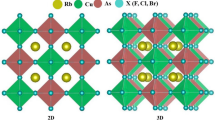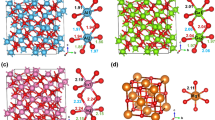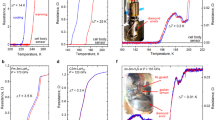Abstract
The structural, electronic, and optical properties of hydrogenated silicene have been studied under different hydrostatic pressures using first-principle calculations. The binding energy and band structure have been calculated for chair (C-) and boat (B-) structures, which are having good stability at 0 GPa, 3 GPa, 6 GPa, 9 GPa, 12 GPa, 15 GPa, and 18 GPa hydrostatic pressures. Stability has been verified using binding energy and phonon calculations. The C- and B-structures have become metallic and unstable at 21 GPa. The optical properties of B-configuration have been studied in the energy range of 0–20 eV. Five optical parameters such as conductivity threshold (σth), dielectric constant ε(0), refractive index n(0), birefringence Δn(0), and plasmon energy (ħωp) have been calculated for the first time under different hydrostatic pressures. The calculated values are in good agreement with the reported values at 0 GPa.










Similar content being viewed by others
Data availability
Authors can provide data whenever it is required.
Code availability
Software application.
References
Novosolov KS, Geim AK, Morozov SV, Jiang D, Zhang Y, Dubonos SV, Grigorieva IV, Firsov AA (2004) Electric field effect in atomically thin carbon films. Science 306:666–669
Yu J, Liu G, Sumant AV, Goyal V, Balandin AA (2012) Graphene-on-diamond devices with increased current-carrying capacity: carbon sp2-on-sp3 technology. Nano Lett 12:1603–1608
Zhang Y, Tan Y, Stormer HL, Kim P (2005) Experimental observation of the quantum Hall effect and Berry’s phase in graphene. Nature 438:201–204
Cahangirov S, Topsakal M, Akturk E, Şahin H, Ciraci S, (2009) Two- and one-dimensional honeycomb structures of silicon and germanium. Phys Rev Lett 102:236804(1–4).
Zhuo Z, Wu X, Yang J (2018) Two-dimensional silicon crystals with sizable band gaps and ultrahigh carrier mobility. Nanoscale 10:1265–1271
Liu CC, Feng W, Yao Y, (2011) Quantum spin Hall effect in silicene and two-dimensional germanium. Phys Rev Lett 107: 076802.
Wang XQ, Li HD, Wang JT (2012) Induced ferromagnetism in one-side semihydrogenated silicene and germanene. Phys Chem Chem Phys 14:3031–3036
Zheng FB, Zhang CW (2012) The electronic and magnetic properties of functionalized silicene: a first-principles study. Nanoscale Res Lett 7:422
Liu CC, Feng W, Yao Y, (2011) Quantum spin Hall effect in silicene and two-dimensional germanium. Phys Rev Lett 107: 076802
Xu C, Luo G, Liu Q, Zheng J, Zhang Z, Nagase S, Gao Z, Lu J (2012) Giant magnetoresistance in silicene nanoribbons. Nanoscale 4:3111–3117
Chen L, Feng B, Wu K, (2013) Observation of a possible superconducting gap in silicene on Ag (111) surface. Appl Phys Lett 102 : 081602
Liu CC, Jiang H, Yao Y, (2011) Low-energy effective Hamiltonian involving spin-orbit coupling in silicene and two-dimensional germanium and tin. Phys Rev B 84:195430.
Ezawa M, (2012) Valley-polarized metals and quantum anomalous Hall effect in silicene. Phys Rev Lett 109:055502.
Wang Y, Zheng J, Ni Z, Fei R, Liu Q, Quhe R, Chengyong X, Zhou J, Zhengxiang G, Lu J (2012) Half-metallic silicene and germanene nanoribbons: towards high-performance spintronics device. NANO 7:1250037
Jose D, Datta A (2013) Structures and chemical properties of silicene: unlike graphene. Acc Chem Res 47:593
Balendhran S, Walia S, Nili H, Sriram S, Bhaskaran M (2015) Elemental analogues of graphene: silicene, germanene, stanene, and phosphorene. Small 11:640
Gao N, Zheng WT, Jiang Q (2012) Density functional theory calculations for two-dimensional silicene with halogen functionalization. Phys Chem Chem Phys 14:257–261
Aghaei SM, Monshi MM, Torres I, Calizo I (2016) Edge functionalization and doping effects on the stability, electronic and magnetic properties of silicene nanoribbons. RSC Adv 6:17046–17058
Tsai WF, Huang CY, Chang TR, Lin H, Jeng HT, Bansil A (2013) Gated silicene as a tunable source of nearly 100% spin-polarized electrons. Nat Comm 4:1500
Lopez-Bezanilla A (2014) Substitutional doping widens silicene gap. J Phys Chem C 118:18788–18792
Gao N, Li J, Jiang Q (2014) Bandgap opening in silicene: effect of substrates. Chem Phys Lett 592:222–226
Ni Z, Liu Q, Tang K, Zheng J, Zhou J, Qin R, Gao Z, Yu D, Lu J (2011) Tunable bandgap in silicene and germanene. Nano Lett 12:113–118
Ding Y, Ni J, (2009) Electronic structures of silicon nanoribbons. Appl Phys Lett 95:083115
Pan F, Wang Y, Jiang K, Ni Z, Ma J, Zheng J, Quhe R, Shi J, Yang J, Chen C (2015) Silicene nanomesh Sci Rep 5:9075
Aghaei SM, Calizo I, (2015) Band gap tuning of armchair silicene nanoribbons using periodic hexagonal holes. J Appl Phys 118:104304.
Houssa M, Pourtois G, Heyns MM, Afanas’ev VV, Stesmans A (2011) Electronic properties of silicene: insights from first-principles modeling. J Elect Soc 158:H107–H110
Fang DQ, Zhang SL, Xu H (2013) Tuning the electronic and magnetic properties of zigzag silicene nanoribbons by edge hydrogenation and doping. RSC Adv 3:24075
Qiu J, Fu H, Xu Y, Zhou Q, Meng S, Li H, Chen L, Wu K (2015) From silicene to half-silicane by hydrogenation. ACS Nano 9:11192
Wang W, Olovsson W, Uhrberg RIG (2016) Band structure of hydrogenated silicene on Ag(111): Evidence for half-silicane. Phys Rev B 93:081406
Qiu J, Fu H, Xu Y, Oreshkin AI, Shao T, Li H, Meng S, Chen L, Wu K (2015) Ordered and reversible hydrogenation of silicene. Phys Rev Lett 114:126101
Osborn TH, Farajian AA, Pupysheva OV, Aga RS, Voon LCLY (2011) Ab initio simulations of silicene hydrogenation. Chem Phys Lett 511:101–105
Houssa M, Scalise E, Sankaran K, Pourtois G, Afanas’ev VV, Stesmans A, (2011) Electronic properties of hydrogenated silicene and germanene. App Phy lett 98:223107
Zhang P, Li XD, Hu CH, Wu SQ, Zhu ZZ (2012) First-principles studies of the hydrogenation efects in silicene sheets. Phys Lett A 376:1230–1233
Ju W, Li T, Su X, Cui H, Li H (2016) Engineering magnetism and electronic properties of silicene by changing adsorption coverage. Appl Surf Sci 384:65–72
Hussain T, Kaewmaraya T, Chakraborty S, Ahuja R (2013) Enhancement of energy storage capacity of Mg functionalized silicene and silicane under external strain. Phys Chem Chem Phys 15:18900
Liu Z, Wu X, Luo T (2017) The impact of hydrogenation on the thermal transport of silicene. 2D Mater 4(2):025002
Zhang P, Li XD, Hu CH, Wu SQ, Zhu ZZ (2012) First-principles studies of the hydrogenation effects in silicene sheets. Phys Lett A 376:1230–1233
Nguyen MT, Phong PN, Tuyen ND (2015) Hydrogenated graphene and hydrogenated silicene: computational insights. Chem Phys Chem 16(8):1733–1738
Fischetti MV, Vandenberghe WG (2016) Mermin-Wagner theorem, flexural modes, and degraded carrier mobility in two-dimensional crystals with broken horizontal mirror symmetry. Phys Rev B 93:155413
Gaddemane G, Vandenberghe WG, Van De Put ML, Chen E, Fischetti MV (2018) Monte-Carlo study of electronic transport in non-σh-symmetric two-dimensional materials: Silicene and germanene. J Appl Phys 124:044306
Khatami MM, Gaddemane G, Van De Put ML, Fischetti MV, Moravvej-Farshi MK, Pourfath M, Vandenberghe WG (2019) Electronic transport properties of silicane determined from first principles. Materials 12:2935
Restrepo OD, Mishra R, Goldberger JE, Windl W (2014) Tunable gaps and enhanced mobilities in strain-engineered silicane. J App Phys 115:033711
Kumar V, Santosh R, Chandra S (2017) First-principle calculations of structural, electronic, optical and thermal properties of hydrogenated graphene. Mat Sci & Engg B 226:64–71
Santosh R, Kumar V (2020) A first-principles study of the stability and structural, optical, and thermodynamic properties of hydrogenated silicene. J Comp Elect 19:516–528
Santosh R, Anita S, Kumar V (2020) Structural, stability, electronic, optical and thermodynamic properties of hydrogenated germanene using first-principle calculations. Mater Sci Engg B 259:114584
Santosh R, Kumar V (2019) The structural, electronic, optical and thermodynamical properties of hydrofluorinated graphene: first-principle calculations. Sol Stat Sci 94:70–76
Santosh R, Kumar V (2019) The effect of pressure on structural, electronic and optical properties of hydrogenated graphene. J Comp Elect 18(3):770–778
Kumar V, Santosh R (2019) First-principle calculations of structural, electronic, optical, and thermodynamic properties of fluorographene. Mat Sci Engg B 246:127–135
Segall MD, Lindan PJD, Probert MJ, Pickard CJ, Hasnip PJ, Clarck SJ, Payne MC (2002) First-principles simulation: ideas, illustrations and the CASTEP code. J Phys: Cond Mat 14:2717
Perdew JP, Burke K, Ernzerhof M (1996) Generalized gradient approximation made simple. Phys Rev Lett 77:3865–3868
Vanderbilt D (1990) Soft self-consistent pseudopotentials in a generalized eigenvalue formalism. Phys Rev B 41:7892–7895
Fischer TH, Almlof J (1992) General methods for geometry and wave function optimization. J Phys Chem 96:9768–9774
Kumar V, Chandra S, Santosh R (2018) First-principles calculations of the structural, electronic, elastic and optical properties of LiGaS2 and LiGaSe2 semiconductors under different pressures. 47:1223–1231
Huang LF, Zeng Z, (2013) Lattice dynamics and disorder-induced contraction in functionalized graphene. J. Appl. Phys. 113:083524
Nair RR, Ren WC, Jalil R, Riaz I, Kravets VG, Britnell L, Blake P, Schedin F, Mayorov AS, Yuan S, Katsnelson MI, Cheng HM, Strupinski W, Bulusheva LG, Okotrub AV, Grigorieva IV, Grigorenko AN, Novoselov KS, Geim AK (2010) Fluorographene: a two-dimensional counterpart of Teflon. Small 6:2877–2884
Sofo JO, Chaudhari AS, Barber GD (2007) Graphane: a two dimensional hydrocarbon. Phys Rev B 75:153401
Sahin H, Topsakal M, Ciraci S (2011) Structures of fluorinated graphene and their signatures. Phys Rev B 83:115432
Sahin H, Ataca C, Ciraci S (2010) Electronic and magnetic properties of graphane nanoribbons. Phys Rev B 81:205417
Segall MD, Shah R, Pickard CJ, Payne MC (1996) Population analysis of plane-wave electronic structure calculations of bulk materials. Phys Rev B 54:16317–16320
Nelson J (2003) The Physics of solar cells. Imperial College Press London. ISBN10: 1860943497
Parlinski K, Kawazoe Y (2000) Ab initio study of phonons and structural stabilities of the perovskite-type MgSiO3. Eur Phys J B 16:49–58
Momida H, Hamada T, Takagi Y, Yamamoto T, Uda T, Ohno T (2007) Dielectric constants of amorphous hafnium aluminates: first-principles study. Phys Rev B 75:195105
Kronig RL (1926) On the theory of dispersion of X-rays. J Opt Soc Amer 12:547–557
Penn DR (1962) Wave-number-dependent dielectric function of semiconductors. Phys Rev B 128:2093
John R, Merlin B (2017) Optical properties of graphene, silicene, germanene, and stanene from IR to far UV–a first-principles study. J Phys Chem of Sol 110:307
Acknowledgements
The authors are thankful to Prof. Rajiv Shekhar, Director of IIT(ISM), Dhanbad, for his continuous encouragement throughout the work. The authors are also thankful to Ms. Bharthi Gajendra for helping in the preparation of the manuscript and calculation.
Author information
Authors and Affiliations
Contributions
Authors have equal contribution in preparing the manuscript.
Corresponding author
Ethics declarations
Conflict of interest
The authors declare no competing interests.
Additional information
Publisher's Note
Springer Nature remains neutral with regard to jurisdictional claims in published maps and institutional affiliations.
Rights and permissions
About this article
Cite this article
Kumar, V., Santosh, R. The stability, structural, electronic, and optical properties of hydrogenated silicene under hydrostatic pressures: a first-principle study. J Mol Model 27, 278 (2021). https://doi.org/10.1007/s00894-021-04895-x
Received:
Accepted:
Published:
DOI: https://doi.org/10.1007/s00894-021-04895-x




